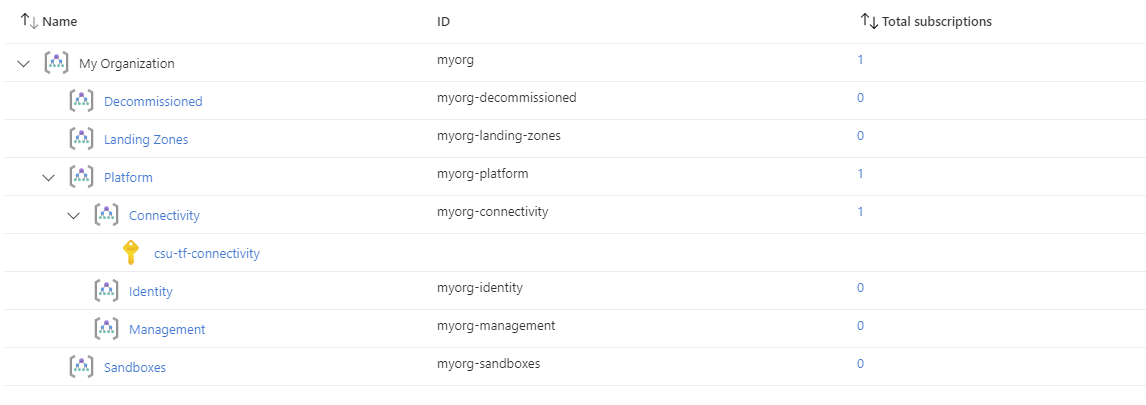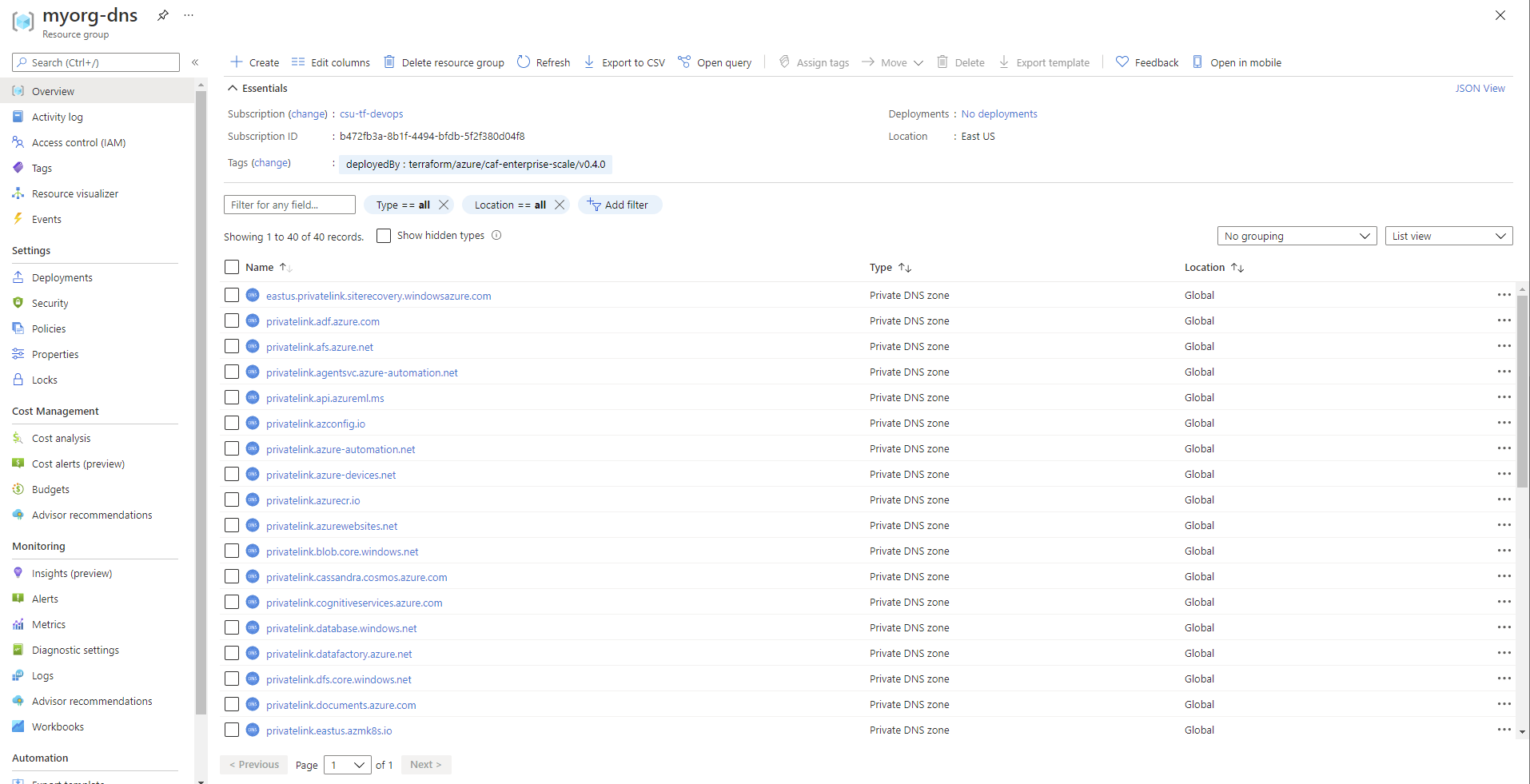-
Notifications
You must be signed in to change notification settings - Fork 574
[Examples] Deploy Virtual WAN Resources
This page describes how to deploy Azure landing zones with connectivity resources based on the Virtual WAN network topology (Microsoft-managed) created in the current Subscription context, using the default configuration settings.
NOTE: If you need to deploy a network based on traditional virtual networks, please see our Deploy Connectivity Resources (Hub and Spoke) example.
As connectivity resources can start to significantly increase Azure consumption costs, the module defaults are aimed to help build the basic connectivity configuration whilst minimizing cost. Please refer to the Network topology and connectivity recommendations to better understand which of these settings you should enable in a Production environment.
In this example, we take the default configuration and make the following changes:
- Set
deploy_connectivity_resourcesto enable creation of the default connectivity resources. - Set
subscription_id_connectivityto ensure the subscription is moved to the correct management group, and policies are updated with the correct values. - Set
configure_connectivity_resourcesto enable creation of the virtual WAN resources.
When deploy_connectivity_resources is set to true, the module updates the parameters and enforcement_mode for a number of policy assignments, to enable features relating to the DDoS protection plan and private DNS zones for private endpoints.
IMPORTANT: Ensure the module version is set to the latest, and don't forget to run
terraform initif upgrading to a later version of the module.
To create the Connectivity resources, deploy_connectivity_resources must be set to true, and the subscription_id_connectivity is also required.
Although subscription_id_connectivity is required, the subscription used for creation of resources is determined by the provider configuration.
Please ensure you have a provider configured with access to the same subscription specified by subscription_id_connectivity, and map this to azurerm.connectivity in the module providers object.
As the module is configured to create a Traditional Azure networking topology (hub and spoke) by default, this example requires configuration of the configure_connectivity_resources input variable.
Although this looks complicated, the value is simply copied from the default value used in the variable and updated according to the variable documentation for Configure hub networks (Virtual WAN).
In this case we perform the following updates:
- Remove the default value from
configure_connectivity_resources.settings.hub_networks - Update the value of the example entry in
configure_connectivity_resources.settings.vwan_hub_networks.enabledfromfalsetotrue
All other settings are the same as a default deployment.
TIP: The exact number of resources created depends on the module configuration, but you can expect upwards of 220 resources to be created by the module for this example.
To keep this example simple, the root module for this example is based on a single file:
# We strongly recommend using the required_providers block to set the
# Azure Provider source and version being used.
terraform {
required_providers {
azurerm = {
source = "hashicorp/azurerm"
version = "~> 3.107"
}
}
}
provider "azurerm" {
features {}
}
# You can use the azurerm_client_config data resource to dynamically
# extract connection settings from the provider configuration.
data "azurerm_client_config" "core" {}
# Call the caf-enterprise-scale module directly from the Terraform Registry
# pinning to the latest version
module "enterprise_scale" {
source = "Azure/caf-enterprise-scale/azurerm"
version = "<version>" # change this to your desired version, https://www.terraform.io/language/expressions/version-constraints
default_location = "<YOUR_LOCATION>"
providers = {
azurerm = azurerm
azurerm.connectivity = azurerm
azurerm.management = azurerm
}
root_parent_id = data.azurerm_client_config.core.tenant_id
root_id = "myorg"
root_name = "My Organization"
deploy_connectivity_resources = true
subscription_id_connectivity = data.azurerm_client_config.core.subscription_id
# Configure custom settings for the module to deploy Virtual WAN hub
# network resources instead of traditional hub network resources.
configure_connectivity_resources = {
settings = {
hub_networks = []
vwan_hub_networks = [
{
enabled = true
config = {
address_prefix = "10.200.0.0/22"
location = ""
sku = ""
routes = []
expressroute_gateway = {
enabled = false
config = {
scale_unit = 1
}
}
vpn_gateway = {
enabled = false
config = {
bgp_settings = []
routing_preference = ""
scale_unit = 1
}
}
azure_firewall = {
enabled = false
config = {
enable_dns_proxy = false
dns_servers = []
sku_tier = "Standard"
base_policy_id = ""
private_ip_ranges = []
threat_intelligence_mode = ""
threat_intelligence_allowlist = {}
availability_zones = {
zone_1 = true
zone_2 = true
zone_3 = true
}
}
}
spoke_virtual_network_resource_ids = []
secure_spoke_virtual_network_resource_ids = []
enable_virtual_hub_connections = false
}
},
]
ddos_protection_plan = {
enabled = false
config = {
location = ""
}
}
dns = {
enabled = true
config = {
location = ""
enable_private_link_by_service = {
azure_api_management = true
azure_app_configuration_stores = true
azure_arc = true
azure_automation_dscandhybridworker = true
azure_automation_webhook = true
azure_backup = true
azure_batch_account = true
azure_bot_service_bot = true
azure_bot_service_token = true
azure_cache_for_redis = true
azure_cache_for_redis_enterprise = true
azure_container_registry = true
azure_cosmos_db_cassandra = true
azure_cosmos_db_gremlin = true
azure_cosmos_db_mongodb = true
azure_cosmos_db_sql = true
azure_cosmos_db_table = true
azure_data_explorer = true
azure_data_factory = true
azure_data_factory_portal = true
azure_data_health_data_services = true
azure_data_lake_file_system_gen2 = true
azure_database_for_mariadb_server = true
azure_database_for_mysql_server = true
azure_database_for_postgresql_server = true
azure_digital_twins = true
azure_event_grid_domain = true
azure_event_grid_topic = true
azure_event_hubs_namespace = true
azure_file_sync = true
azure_hdinsights = true
azure_iot_dps = true
azure_iot_hub = true
azure_key_vault = true
azure_key_vault_managed_hsm = true
azure_kubernetes_service_management = true
azure_machine_learning_workspace = true
azure_managed_disks = true
azure_media_services = true
azure_migrate = true
azure_monitor = true
azure_purview_account = true
azure_purview_studio = true
azure_relay_namespace = true
azure_search_service = true
azure_service_bus_namespace = true
azure_site_recovery = true
azure_sql_database_sqlserver = true
azure_synapse_analytics_dev = true
azure_synapse_analytics_sql = true
azure_synapse_studio = true
azure_web_apps_sites = true
azure_web_apps_static_sites = true
cognitive_services_account = true
microsoft_power_bi = true
signalr = true
signalr_webpubsub = true
storage_account_blob = true
storage_account_file = true
storage_account_queue = true
storage_account_table = true
storage_account_web = true
}
private_link_locations = []
public_dns_zones = []
private_dns_zones = []
enable_private_dns_zone_virtual_network_link_on_hubs = true
enable_private_dns_zone_virtual_network_link_on_spokes = true
virtual_network_resource_ids_to_link = []
}
}
}
location = null
tags = null
advanced = null
}
}
You have successfully created the default management group resource hierarchy, along with the recommended Azure Policy and Access control (IAM) settings for your Azure landing zone.
You have also assigned the current subscription from your provider configuration to the connectivity management group.
Check the following policy assignments to see how these have been configured with default settings for parameters and enforcement mode:
- Scope =
connectivityandlanding-zonesEnable-DDoS-VNET
- Scope =
corpDeploy-Private-DNS-Zones
You may want to Deploy Virtual WAN Resources With Custom Settings to change some of these settings.
Once deployment is complete and policy has run, you should have the following resource groups deployed in your assigned connectivity subscription:

NOTE:
myorg-asc-exportis related to the management resources. This should contain a hiddenmicrosoft.security/automationsresourceExportToWorkspaceonce the management resources are configured and Azure Policy has completed remediation.NetworkWatcherRGis also automatically generated by the Azure platform when at least one virtual network is created within the subscription.
The Resource Group myorg-connectivity should be created, and will initially contain a single virtual WAN with the name myorg-vwan-eastus.
There will also be a hidden virtual hub resource with the name myorg-vhub-eastus.

When you explore the configuration, note that no connectivity settings have been configured.
DDoS Network Protection should also be disabled to reduce costs, although we recommend you enable this for production environments.
The location of both the resource group and virtual WAN resources is created in the region specified via the default_location input variable, which uses the default value of eastus in this example.
These settings can all be changed if needed!
NOTE: The module is designed to follow the documented recommendation to deploy all Virtual WAN resources into a single resource group regardless of
locationof the virtual WAN resources. We therefore omit the location identified from the name for these resources.
As DNS resource are Global resources, the resource group is created in the region specified via the default_location input variable, which uses the default value of eastus in this example.
All private DNS zone resources are Global.

By default we create a private DNS zone for all services which currently support private endpoints. New private DNS zones may be added in future releases as additional services release private endpoint support.
We also configure virtual network links to connect each private DNS zone to traditional hub virtual networks, but this is not currently supported for virtual hubs.
This can be optionally enabled for spoke virtual networks being peered to the virtual hub.
If you are using archetype exclusions or custom archetypes in your code, make sure to not disable DDoS or DNS policies if you require policy integration using this module. The relationship between the resources deployed and the policy parameters are dependent on specific policy assignments being used.
Go to our next example to learn how to deploy the Virtual WAN resources with custom settings.
To learn more about module configuration using input variables, please refer to the Module Variables documentation.
Looking for further inspiration? Why not try some of our other examples?
This wiki is being actively developed
If you discover any documentation bugs or would like to request new content, please raise them as an issue or feel free to contribute to the wiki via a pull request. The wiki docs are located in the repository in the docs/wiki/ folder.
- Home
- User guide
- Video guides
-
Examples
- Level 100
- Level 200
-
Level 300
- Deploy multi region networking with custom settings (Hub and Spoke)
- Deploy multi region networking with custom settings (Virtual WAN)
- Deploy with Zero Trust network principles (Hub and Spoke)
- Deploy identity resources with custom settings
- Deploy management resources with custom settings
- Expand built-in archetype definitions
- Create custom policies, initiatives and assignments
- Override module role assignments
- Control policy enforcement mode
- Policy assignments with user assigned managed identities
- Level 400
- Frequently Asked Questions
- Troubleshooting
- Contributing
